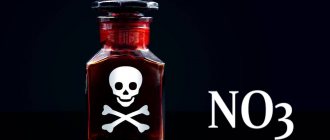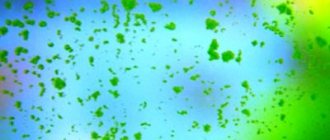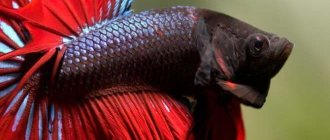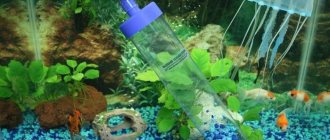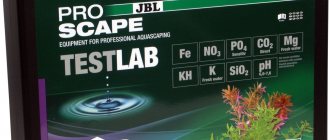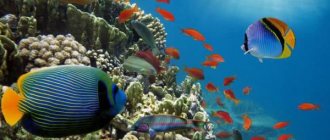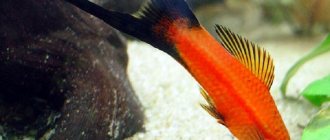Very often we cannot identify hazardous substances contained in the air, either by smell or visually. For example, carbon monoxide. Which is formed in the exhaust fumes of a car. Since it has neither color nor smell, and is very dangerous to health. And often, people realize that they have been poisoned only when it is too late. Ammonia works in the same way in an aquarium. For us, the water in the aquarium is usually crystal clear and without any specific odors. But it may already contain an increased concentration of this chemical. And we can recognize this only by the appearance and behavior of the fish. And most likely only when the ammonia has already managed to poison the entire population of the aquarium.
Ammonia is present everywhere in nature. And it is an important link in the biological cycle of living organisms. But there is a fine line between acceptable norms and poisoning.
Ammonia in water. Where?
If you read my article about the chemical balance in an aquarium and look at the specially made drawing, then you will immediately understand all the main processes occurring in it.
Ammonia is formed as a result of the life of fish. Mainly in the gills. Fish, unlike other living creatures, when breathing, emit not only safe carbon dioxide. But ammonia is also very poisonous and perfectly soluble in water. It is also formed in fish waste and the remains of uneaten food. And it is usually presented in aquarium water in two of its forms. As free ammonia ( NH3
) and ammonium ions (
NH4
).
Therefore, on tests to determine the amount of ammonia, the NH3/NH4
,
But under normal conditions, in an aquarium with an established biological balance, and in which beneficial nitrifying agents
bacteria (
Nitrosomonas
) – the ammonia concentration is close to zero and does not pose any danger to the inhabitants of the aquarium.
The fact is that these bacteria process ammonia into still dangerous nitrites
, and nitrites are processed by other bacteria into relatively safe
nitrates
.
Price and where to buy
You can purchase a suitable tester at a zoological store. Also, such devices are sold in specialized aquatic centers and places selling equipment. The cost of such products may vary depending on the type and brand. It is necessary to note the average price indicators:
- pH - from 450 rubles;
- KH – from 300 rubles;
- GH – from 500 rubles;
- NO3 – from 500 rubles;
- PO4 – from 600 rubles;
- Ammonia - from 500 rubles.
Test strips are sold in packs of 50 and 100 pieces. When purchasing an electronic tester, the cost of such a device will be from 2000 rubles. Complex kits for water analysis cost from 1500 and above, depending on the number of reagents. It is necessary to purchase testers only in trusted places that have appropriate certificates for sale. Often, buying from unverified people can lead to fakes that give false results. It is important to monitor the expiration date of reagents.
Water is no less important for fish than air is for humans.
Aquarium care begins with regular water analysis. Beginning aquarists often believe that purchasing tests is a waste of money, but this is not the case. The lack of necessary testers leads to problems that can subsequently lead to the death of aquatic life. Therefore, their use allows you to regularly maintain conditions for keeping fish. Everyone chooses the variety and brand independently, depending on personal preferences.
Was this information useful to you? Share in the comments!
What causes ammonia levels to rise?
Ammonia levels can increase for many different reasons. Below is a list of the most common reasons that are worth checking if ammonia is detected in the aquarium.
- New aquarium with insufficient population of beneficial bacteria.
- The filter was washed under tap water, or the old filter medium was replaced.
- Disease control measures have killed the population of beneficial bacteria in the filter.
- Excessive feeding.
- Repopulation of fish.
- Insufficient filtration.
- Improper purification of tap water (chlorine or chloramine content).
- Adding too many new fish in too short a period of time.
- Decomposition of dead fish remains in an aquarium.
- Placing an untrained breed in an aquarium.
Biological method
The previously mentioned biological method involves purifying water from ammonia using microorganisms. Usually these are simple bacteria, algae, fungi, and invertebrates. Water purification from ammonia by microorganisms occurs naturally. But this cleaning method is quite difficult, as it requires:
- Applications of microorganisms
- Subsequent cleaning
- Water disinfection
Therefore, it remains very expensive. It also requires the supervision of specialists and some control over ongoing processes using special equipment. And further purification of water from microorganisms is carried out only in the presence of disinfecting filters.
How to recognize high ammonia in an aquarium?
The visual and most urgent sign of ammonia in the water.
If you suddenly notice changes in the behavior of fish. Such as lethargy and changes in coordination of movements. It is difficult for the fish to breathe and they stay near the surface. They are trying to jump out of the water. They eat food poorly. The water has an unusual smell. Plus, if your aquarium is overcrowded, there are no live plants, and there is not enough filtration. We can say with great confidence that this is ammonia
, and it is urgent to take immediate action.
Pest Control
The main effect is to repel harmful insects such as aphids, mole crickets, and onion flies. The substance is not poisonous, so treating vegetable crops against flightless parasites is ineffective.
When using, you must remember that an excess of nitrogen-containing drugs is no less harmful than their deficiency. Plants have the ability to absorb the composition through their leaves.
Processing must be carried out according to the rules.
- In dry and windless weather.
- Watering young seedlings is prohibited to avoid burns.
- Follow the dosage.
- Apply once every seven days.
- Store in an airtight container to prevent loss of properties.
Determination of ammonia using tests.
Now, almost all manufacturers of aquarium equipment have special tests to determine the concentration of ammonia in water. From the simplest and not very accurate, to more advanced drip ones. The principle of operation is approximately the same for all. Or wet the strip, wait, and compare the results with the color scale on the attached diagram. Or take a water sample and add a few drops of the solution from the test kit. We waited and also compared it with the color scale. In any case, detailed and clear instructions will be included.
Below, the photo shows my ammonia tests in one of the aquariums.
As we can see, for correct test readings, we still need to take into account the pH of the water.
Introduction
The proportion of ammonia depends on the pH, salinity and temperature of the environment. Typically, for every unit increase in pH, there is a tenfold increase in the concentration of ammonia, which is formed when the equilibrium shifts to the left. For example, when alkalinity increases from 7 to 8 units, the share of nitrogen in ammonia increases from 0.33 to 3.3%, while the share of nitrogen in NH4+ drops from 99.7 to 96.7%. Thus, toxicity is more pronounced under alkaline conditions. An increase in temperature and salinity also leads to an increase in the proportion of non-ionized NH3 [1].
| Temperature (°C) | |||||||||||||
| pH | 6 | 8 | 10 | 12 | 14 | 16 | 18 | 20 | 22 | 24 | 26 | 28 | 30 |
| 7.0 | .0013 | .0016 | .0018 | .0022 | .0025 | .0029 | .0034 | .0039 | .0046 | .0052 | .0060 | .0069 | .0080 |
| 7.2 | .0021 | .0025 | .0029 | .0034 | .0040 | .0046 | .0054 | .0062 | .0072 | .0083 | .0096 | .0110 | .0126 |
| 7.4 | .0034 | .0040 | .0046 | .0054 | .0063 | .0073 | .0085 | .0098 | .0114 | .0131 | .0150 | .0173 | .0198 |
| 7.6 | .0053 | .0063 | .0073 | .0086 | .0100 | .0116 | .0134 | .0155 | .0179 | .0206 | .0236 | .0271 | .0310 |
| 7.8 | .0084 | .0099 | .0116 | .0135 | .0157 | .0182 | .0211 | .0244 | .0281 | .0322 | .0370 | .0423 | .0482 |
| 8.0 | .0133 | .0156 | .0182 | .0212 | .0247 | .0286 | .0330 | .0381 | .0438 | .0502 | .0574 | .0654 | .0743 |
| 8.2 | .0210 | .0245 | .0286 | .0332 | .0385 | .0445 | .0514 | .0590 | .0676 | .0772 | .0880 | .0998 | .1129 |
| 8.4 | .0328 | .0383 | .0445 | .0517 | .0597 | .0688 | .0790 | .0904 | .1031 | .1171 | .1326 | .1495 | .1678 |
| 8.6 | .0510 | .0593 | .0688 | .0795 | .0914 | .1048 | .1197 | .1361 | .1541 | .1737 | .1950 | .2178 | .2422 |
| 8.8 | .0785 | .0909 | .1048 | .1204 | .1376 | .1566 | .1773 | .1998 | .2241 | .2500 | .2774 | .3062 | .3362 |
| 9.0 | .1190 | .1368 | .1565 | .1782 | .2018 | .2273 | .2546 | .2836 | .3140 | .3456 | .3783 | .4116 | .4453 |
| 9.2 | .1763 | .2008 | .2273 | .2558 | .2861 | .3180 | .3512 | .3855 | .4204 | .4557 | .4909 | .5258 | .5599 |
| 9.4 | .2533 | .2847 | .3180 | .3526 | .3884 | .4249 | .4618 | .4985 | .5348 | .5702 | .6045 | .6373 | .6685 |
| 9.6 | .3496 | .3868 | .4249 | .4633 | .5016 | .5394 | .5762 | .6117 | .6456 | .6777 | .7078 | .7358 | .7617 |
| 9.8 | .4600 | .5000 | .5394 | .5778 | .6147 | .6499 | .6831 | .7140 | .7428 | .7692 | .7933 | .8153 | .8351 |
| 10.0 | .5745 | .6131 | .6498 | .6844 | .7166 | .7463 | .7735 | .7983 | .8207 | .8408 | .8588 | .8749 | .8892 |
| 10.2 | .6815 | .7152 | .7463 | .7746 | .8003 | .8234 | .8441 | .8625 | .8788 | .8933 | .9060 | .9173 | .9271 |
The share of the toxic (non-ionized) form of NH3 in solution at different values of acidity and ambient temperature [2].
Ammonia in the aquarium. How to reduce dangerous concentrations?
Water change.
The simplest and most effective way to lower ammonia levels in an emergency is to replace part of the aquarium water with clean tap water. 35 percent, and sometimes even 50 percent. Just watch the temperature of the fresh water. Fish, cold-blooded animals. And they completely depend on the temperature of their environment. Sudden changes in temperature are contraindicated for them.
Use of zeolite.
A slower, but also very effective way to combat ammonia in an aquarium. Simply place a nylon bag with zeolite in the aquarium filter.
Zeolite
- a natural mineral, the main useful feature of which is its ability to remove ammonia from aquarium water.
This filter media is available from all aquarium product manufacturers. And you can buy it without any problems at any pet store.
If it is not possible to place it inside the filter, simply place a bag of zeolite next to the air atomizer. Or near the outlet of the aquarium filter. Use a suction cup to attach to glass. Zeolite, unlike activated carbon, can be used repeatedly. To do this, the used zeolite is poured with a 10-15% solution of table salt for a day. Then rinse with running water and use again.
Chemicals for the control of ammonia.
There are drugs on the market that help neutralize ammonia in the aquarium and protect fish from its harmful effects. For example, API AMMO LOCK
. Removes ammonia from the water and at the same time protects the gills of fish, thereby reducing stress in case of poisoning. Before use, you must replace some of the water with fresh water.
HYDRA IN THE AQUARIUM: DESCRIPTION, DISPOSAL, PHOTO, VIDEO
FLIPPER IN THE AQUARIUM: DESCRIPTION, RIDING, SYMPTOMS, PHOTO, VIDEO
Precautionary measures
The main danger factor is the pungent odor and the possibility of chemical burns. This is especially true at high concentrations. Therefore, when working with the composition, it is necessary to use gloves and respiratory protection.
Contact with skin can also cause burns. Therefore, it is better to use special clothing.
The most common hazard comes from vapors, which, if inhaled, can cause dizziness, gagging, disorientation and tearing. At the first symptoms, it is necessary to interrupt work and provide ventilation. Usually, if you follow the recommendation in time, there are no serious consequences. However, with prolonged contact, there may be options when it is impossible to do without contacting medical institutions.
Pros of the substance
Due to its unique properties and fairly simple manufacturing method, this product has been used since the times of ancient Egypt. If previously it was used exclusively in medicine and as a cleaning agent, then with the development of science and technology its scope of consumption has increased sharply.
Simple processes and relative safety of production ensured the use of the drug in agriculture and the chemical industry.
The most important advantage is the low cost of the composition. This allows it to be used in a variety of areas of the economy. The simplicity and safety of storage significantly reduces the costs of these processes. If the technology is followed, the shelf life is unlimited. Caking is eliminated - a big problem for business executives when using saltpeter.
The absorption of nitrogen by plants occurs without additional waste of water. Therefore, this feeding is very popular in regions where there is a lack of moisture.
Many N-based fertilizers are explosive. The solution lacks this quality and is completely harmless. If an emergency spill is allowed in an emergency situation, then catastrophic contamination of the area will not occur. Due to evaporation, the space is cleared in a short period of time, which is impossible when large volumes of granular fertilizers fall on the soil. For example, when saltpeter is spilled, the soil becomes unsuitable for growing plants for a very long period. Thanks to nitrification, introduced ammonia creates stable compounds in the soil that are not subject to decomposition.
Ammonium salts
Main table dispenser AquaPro 919H/RO (hot and cold water)
Main table dispenser AquaPro 929CH/RO (cooling/heating)
Floor dispenser AquaPro 311 (empty, without cooling)
This group of chemical products is obtained by reaction with various acids.
Application area.
- Nitrates are used as fertilizers and in the production of explosives.
- Sulfates are a cheaper class of plant food.
- Hydrocarbonates are used in the food industry as a leavening agent and preservative.
- Carbonates are part of the technological chain for the production of dyes and plastics.
- Chlorides are used in veterinary medicine.
All materials have clear characteristics of classical salts, which are closest in characteristics to sodium compounds. They dissolve well with dissociation into ions. When heated they decompose. When exposed to alkalis, ammonia is released.
